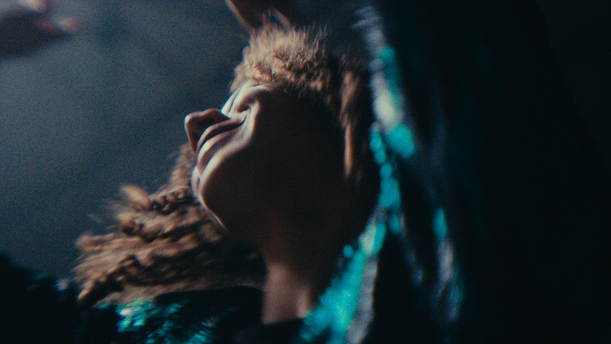Le Palace has been selected for

The discotheque of Barthes
To define a club, as many have tried, is to resist reducing it into a singular essence. French philosopher Roland Barthes, reflecting on his nights at the Parisian nightclub Le Palace, understood this resistance. He noted that Le Palace was not merely a boîte—a “box,” as the French often describe a nightclub. It was a total work of art.
While club culture was not a new phenomenon, the 1980s marked its transformation into a lifestyle. At the heart of this shift was Le Palace, a refuge for cultural creatives: writers, artists, musicians, and those who thrived in the late hours of the night. This lifestyle wasn’t born of necessity or desperation. It was the result of a reimagined nightclub experience.
The discotheque had evolved into a dynamic site, where new technologies like pre-recorded sound, kinetic lighting, and immersive décor redefined its space.

Een club definiëren, zoals velen hebben geprobeerd, is een oefening in het weerstaan van het terugbrengen ervan tot een enkelvoudige essentie. De Franse filosoof Roland Barthes, die reflecteerde op zijn avonden in de Parijse nachtclub Le Palace, begreep deze weerstand. Hij merkte op dat Le Palace niet zomaar een boîte was—een “doos,” zoals de Fransen een nachtclub vaak beschrijven. Hoewel clubcultuur geen nieuw fenomeen was, markeerden de jaren 80 de transformatie ervan naar een levensstijl. Le Palace was de belichaming van deze verandering, een toevluchtsoord voor culturele creatieven: schrijvers, kunstenaars, muzikanten en anderen die gedijden in de late uren van de nacht. Dit was geen reactie op nood of wanhoop; het was het resultaat van een heruitgevonden nachtclubervaring. De discotheek werd een dynamische plek waar nieuwe technologieën zoals vooraf opgenomen geluid, kinetische verlichting en meeslepende decors de ruimte opnieuw definieerden. Le Palace werd hierdoor een plek in constante verandering, gevormd door de energie en creativiteit van degenen die het bewoonden. Elke nacht bood de belofte van iets volledig nieuws—een bestaan dat onbegrensd en ondefinieerbaar was.
The Dancefloor of Le Palace at 8, Rue du Faubourg-Montmartre.
To imagine a palace
In this project, we draw inspiration from the rich archives of Le Palace. Filled with images of extravagant parties, elaborate costumes, and unrestrained decadence. It appears as a nighttime utopia, a space of freedom, self-expression, and outsider art.
Yet, for all its allure, Le Palace belongs to the past, a nostalgic memory that isn’t even our own. The unconventional clubbing spaces and underground scenes it represented seem to have disappeared. Today, the night feels like a battleground. We fight for the right to exist, to express, to connect, to dance, for that fleeting moment on the dancefloor that might turn into something more.
Leaving us with the question: What would Le Palace look like if its spirit were brought into our era? Imagine taking its extravagance from the theaters and streets of Paris and placing it in the contemporary pulse of the electronic music scene.
However, it will not be a remake but a reinterpretation—contemporary, abstract, minimal, and stripped down. Our Le Palace exists in the space between the real and the imagined, like a daydream, stretched, distorted, playful, and provocative.
In dit project laten we ons inspireren door de rijke archieven van Le Palace. Gevuld met beelden van extravagante feesten, uitbundige kostuums en ongeremde decadentie. Het lijkt een utopie van de nacht, een ruimte voor vrijheid, zelfexpressie en outsiderkunst. Maar hoe verleidelijk het ook is, Le Palace behoort tot het verleden, een nostalgische herinnering die niet eens de onze is. De onconventionele clubruimtes en undergroundscènes die het vertegenwoordigde, lijken verdwenen. Vandaag voelt de nacht als een strijdtoneel. We vechten voor het recht om te bestaan, ons uit te drukken, te verbinden, te dansen, voor dat ene vluchtige moment op de dansvloer dat misschien iets meer wordt. Dit roept de vraag op: Hoe zou Le Palace eruitzien als haar wezen naar onze tijd werd getransporteerd? Stel je voor dat we de extravagantie uit de theaters en straten van Parijs verplaatsen naar de hedendaagse puls van de elektronische muziekscene. Toch wordt het geen reconstructie, maar een herinterpretatie—hedendaags, abstract, minimalistisch en uitgekleed. Ons Le Palace bevindt zich in de ruimte tussen het werkelijke en het denkbeeldige, als een dagdroom, uitgerekt, vervormd, speels en provocerend.
Towards an installation work

The first drawing of the installation piece on a coaster, november 2022.
Le Palace is a 13-minute installation work, which can also be experienced as a linear film. It takes you out on the town, with the viewer as the main character. This utopian imagining invites you to lose yourself in the sense of imminent freedom that nightlife promises. Yet, alongside this freedom lies the insecurity and fragility that always accompany escapism. The work asks: Can escapism and the longing for freedom always endure, even in today’s modern society? What does freedom look like now? And can, or rather is there a need, for Le Palace to exist in present times?
Le Palace is een 13 minuten durende installatie, die ook als lineaire film kan worden getoond. Het neemt je mee op een nacht uit, met de toeschouwer als hoofdpersonage. Deze utopische verbeelding nodigt uit om jezelf te verliezen in het gevoel van de nabijheid van vrijheid die het nachtleven belooft. Toch gaat deze vrijheid altijd gepaard met de onzekerheid en kwetsbaarheid die escapisme met zich meebrengt. Het werk stelt de vraag: Kunnen escapisme en het verlangen naar vrijheid altijd blijven bestaan, zelfs in de moderne samenleving van vandaag? Hoe ziet vrijheid er nu uit? En kan, of misschien juist móét, Le Palace in onze tijd bestaan?

Booklet Le Palace.
Booklet Le Palace
Voice-over Le Palace, written by Anouk Harkmans.
Installation lay-out













